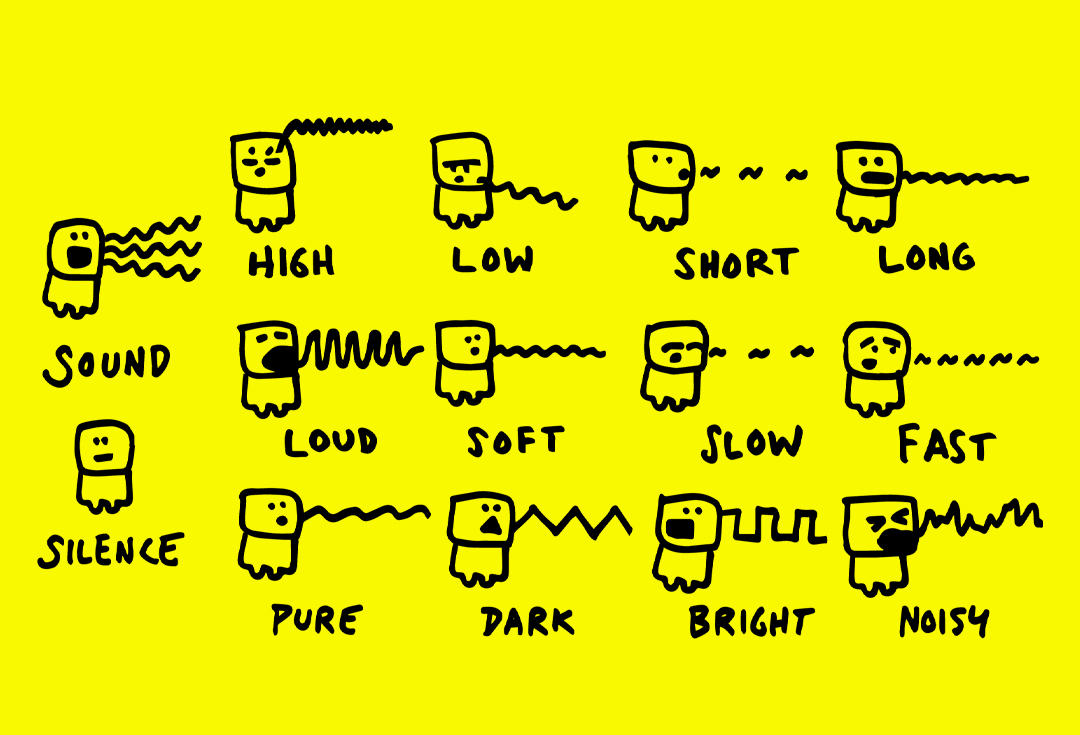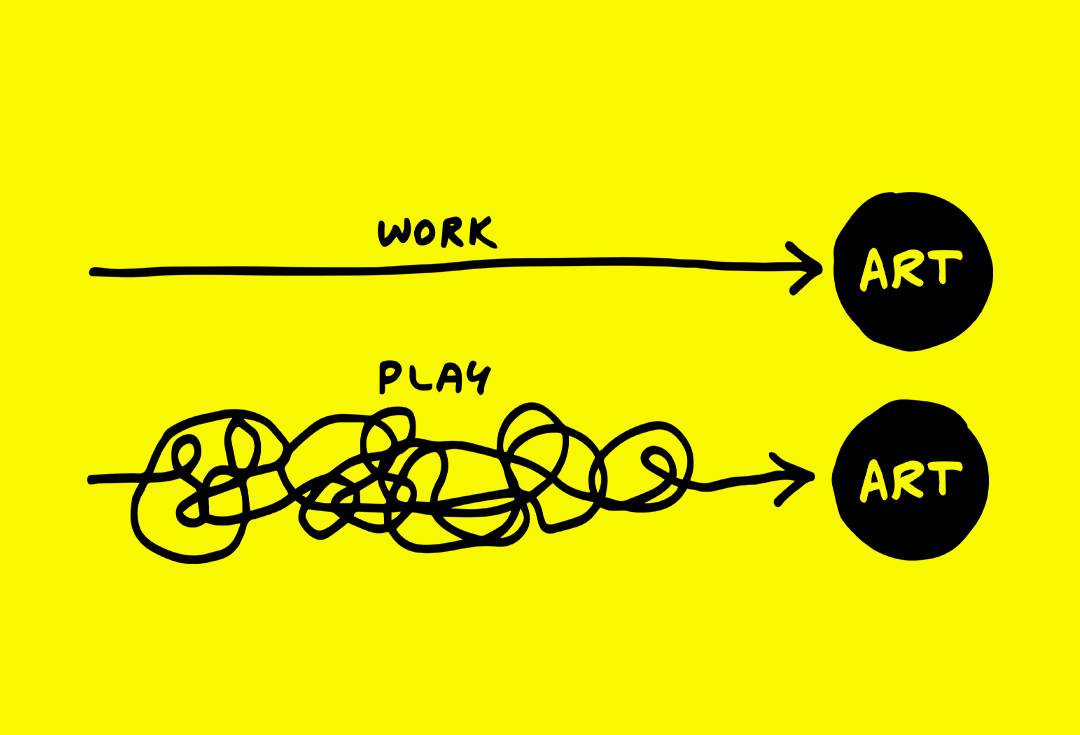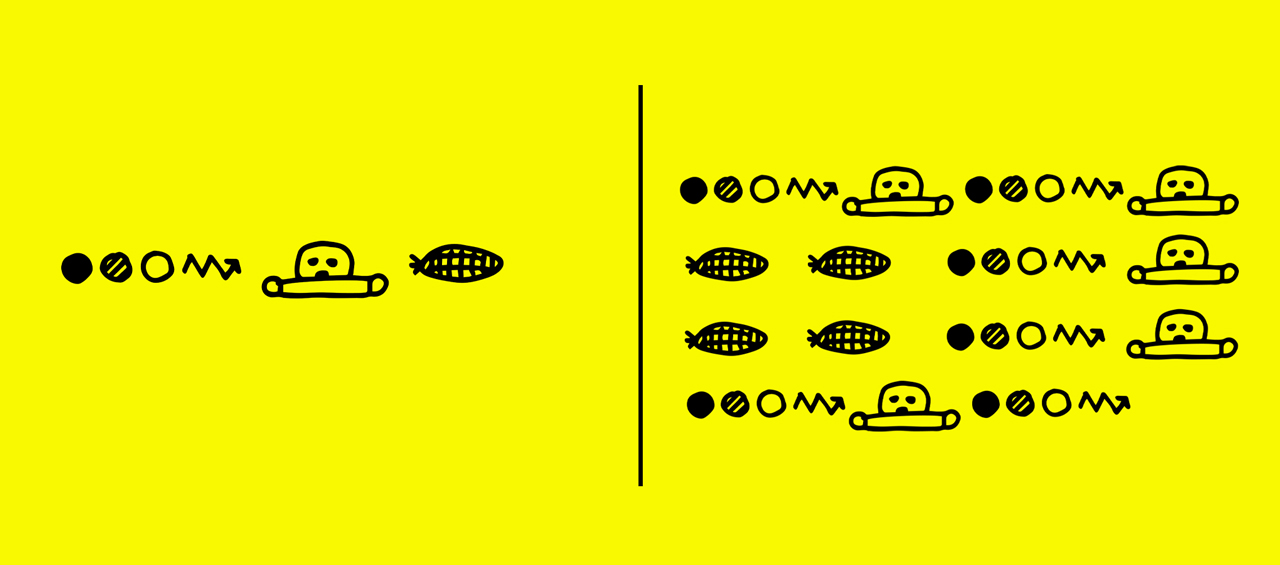

“There is nothing new under the sun, but there are new suns.” –Octavia Butler

7–9 minute experience, or the time it takes for a midday stretch.
Making music might seem intimidating, but composer and educator Danny Clay dedicates much of his artistic practice to ensuring his students feel empowered and excited to do it. Through games, creative prompts, and experimentation, he encourages folks of all ages to play with and pay attention to the sounds around them. In the following interview, Clay discusses the delight of silence and open-ended questions.
Danny Clay: I’ve been thinking about this question a lot lately as it relates not only to making music, but teaching music as well. Silence plays such a deeply important role in the world, and yet I feel like I’m only beginning to wrap my head around it! Earlier in the summer I made a drawing for my Kindergarten students that outlined some simple ways to describe sound:

[ID: A series of illustrations depicting line drawings of a person singing musical notes in various ways. In each illustration, their “voice” is depicted by a line that matches the musical parameter described, so a long line indicates a long note, short lines for short notes, a bumpy line for a noisy note and a gently flowing line for a pure note. On the far left, there is a figure with their mouth open labeled “sound,” and a figure with their mouth closed labeled “silence.”]
I feel that silence — and here I guess I mean a state of deep and attentive listening — is the bedrock on which art is made and understood.
It wasn’t until later that I realized this is only half of the picture! What kinds of silences are there, and can we hear and differentiate between the nature of various kinds of silences? (I need to think about it some more!)
Sound and silence elevate, punctuate, support, and amplify one another, not only in the music itself, but in the creative process. Furthermore, I feel that silence — and here I guess I mean a state of deep and attentive listening — is the bedrock on which art is made and understood. An artist is constantly making adjustments and noticing the effects of those adjustments, and when a work is ready to share with others, the community surrounding that artist becomes an active and transformative part of the process through their reactions, attention, and reflections on the work. In the classroom this is equally true: if we’re working on a project and a student is just not up for contributing sounds that day, we can always lean on the fact that just being present and listening is an equally meaningful contribution to a community.

[ID: Two illustrations featuring arrows that point to the word “Art.” The top illustration is a straight arrow labeled “work.” The bottom illustration is a haphazardly squiggly arrow labeled “play.”]
Danny: The straight line represents how a “work-based model” has always kind of felt to me. When I think of “work,” it brings to mind this idealized process of following a procedure to get something done as efficiently as possible. If I hold that expectation of a sleek, optimized process in my head as I’m creating something, I find it anxiety-inducing because it’s such an unrealistic model of what creativity is for me. Similar to a child’s experience of play, my process is loaded with moments of backtracking, detours, sidesteps, erasures, false starts, and restarts. It’s a squiggly line. So I think framing what I do as “play” encouraged me to embrace that squiggliness as not only part of the creative process, but the absolute essence of it. Thinking about art-making as playing allows me to indulge in those curiosities and tangents that arise spontaneously as I shuffle material around, and what I learn from those diversions imbues a depth of meaning into the final form that I don’t think is as rich or heartfelt when I try to work along a clearly plotted, beginning-to-end path.
Often when “play” starts to feel like “work,” it’s because I’ve unconsciously gone back to imagining my process as trudging along that unrealistically efficient line. If this happens, I try to allow myself permission to go off on whatever creative detour I want to, even if it feels totally unrelated to the project at hand. More often than not, that detour usually ends up becoming an invaluable part of whatever the project ends up shaping up to be.

[Audio description: The sound of a plastic recorder being blown into sideways, across the holes. The sound is a series of crisp, short, hollow bursts of wind.]
Danny: All of these things are wrapped up in my utter obsession with creative prompts. I love open-ended challenges because it gives the people who engage with them an opportunity to bring their own strengths and insights to the situation while also fostering exploration and growth. A challenge could be a question: Can you find three high-sounding objects in the room you’re in right now? If the two of us were in a room together, but blindfolded, how could we make a sound at the exact same time? How would you turn this sound from my plastic recorder into a drawing? The beauty of such invitations is that everyone will respond to them differently. There are as many answers as there are people! For example, three different elementary schoolers drew the sound above like this:

[ID: Left image: Three different children’s drawings that represent the sound of a plastic recorder being blown. One is a series of shaded circles, one is shaped like an ear of corn, and one looks like a person holding a recorder sideways to blow into it. Right image: The recorder symbols from the previous drawing, now organized into a pattern.]
I love how answers to these kinds of invitations can generate new questions, too. What if those drawings above actually made different sounds, and what would those be? Could we arrange those drawings into some kind of pattern to create a composition? How would this sound?
This process of successive inquiries could continue endlessly and in infinite directions. You could make a video game with these icons as characters, or choreograph a dance by adding movements to each sound. Sound itself is interesting to me, but the idea that sound can be played with in the manner of a game, or even translated — to images, movement, sculpture, poetry, etc. — is tremendously exciting. I think of composing as “putting stuff together.” Once that definition softens to include combining all kinds of stuff — a sound existing with a particular smell, a dancer moving with a projected image, a poem written on the walls of a maze — there’s a lot more potential to imagine new and meaningful connections between the “stuff” that’s all around us.
I love open-ended challenges because it gives the people who engage with them an opportunity to bring their own strengths and insights to the situation while also fostering exploration and growth.
Listen to from place to place
BY DANNY CLAY
Part 1 of from place to place, listen with headphones. For the entire album, go to this bandcamp page.
The composition included here, from place to place, began with a rather simple prompt:
I received dozens of realizations of this prompt from over a hundred young musicians and collaged them together to create the album and a corresponding sound installation.
Audio Description of from place to place:
Part 1: A swirl of rain-like sounds created from vocal clicks, lip pops, and fingers snapping and tapping. Metal handbells gradually enter and add to the mix, growing in range and resonance — these cascading layers build in intensity until a series of loud clock-like chimes are heard. All of the sounds are suddenly swept away, save for a few light droplets of vocal sounds.
Part 2: Droning cellos play long tones as viola and violin melodies are gradually introduced. These lines are simple and lyrical and interact in surprising and seemingly improvisational ways. The texture thins to quiet, delicate scrapes and plucks before a guitar and violin pick up a mellow, dance-like duet. A low harp sets off a flurry of violin arpeggios, which gradually fade while string melodies reminiscent of the opening enter and overlap.
Part 3: Buzzing, humming, chattering vocal sounds imitating traffic, public transportation, and street noise fade in and out across the stereo field. Vocal drones enter and recede, casting the street sounds in harmony with one another. A choral imitation of car horns and a fender bender causes the noise to retreat into silence.
Part 4: Delicate, tinkling percussive sounds imitating a river are punctuated by cascading, melancholy guitar chords. A hypnotic guitar loop enters while a cello plays a simple, folk-like melody.
Part 5: Vocal sounds imitating wind and leaves are punctuated by single tines of music boxes like fireflies. These sounds intermingle as sparse handbells are added to the texture. Vocal harmonies emerge and recede, until a collection of plucked combs is all that remains, like the crackling embers of a campfire.
Danny: Absolutely! This music was originally commissioned as a sound installation by the City of Berkeley for an outdoor transit space, so I reached out specifically to youth from the greater Bay Area hoping that in some way the sounds contributed might offer a portrait, both descriptive and speculative, of our collective home. I was struck by how beautiful, observant, and well-rounded the responses were, from sonic representations of trees blowing, to fender benders, to wind and waves and even slugs. I was moved when I visited a middle school handbell choir and they chose to focus largely on the sounds of rain as their contribution to the community, especially given that California has suffered from a severe drought in recent years.
Note: This interview was conducted via email in August 2022 by Jessica Ferrer.

[ID: A white male in his early thirties with short brown hair and a beard is wearing a grey sweater against an adobe wall, holding a rock that says, “Hi Danny!”]
Danny Clay
He // Him // His
San Francisco, CA
Danny Clay is a composer and educator whose work is deeply rooted in curiosity, collaboration, and the sheer joy of making things with people of all ages and levels of artistic experience. Clay sees “composing” as the act of putting things together and strives to find ways to utilize this act to foster creativity and connection — whether it be playing musical games with visitors to Chicago’s Millennium Park, or building holiday-themed sound installations with classes of elementary schoolers. Working closely with artists, students, and community members alike, he builds worlds of inquiry, play, and perpetual discovery that often integrate elements of sound, movement, theater, and visual design. Simple games, speculative systems, cognitive puzzles, invented notation, found objects, imaginary archives, repurposed media, micro-improvisations, and happy accidents all make frequent appearances in his work as both an artist and teaching artist. In addition to art-making, Clay loves to offer creative resources for educators and learners alike in the form of lesson plans, activities, interactive web games, and workshops.
